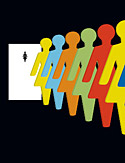Bladder 101: 5 Tips for Controlling OAB

Illustration: Spacher
If it feels as if you plan your life around the proximity of the nearest bathroom, you're not alone.
An estimated one in six adults has overactive bladder (OAB). Common symptoms include a sudden, uncontrollable urge to go; needing to go more than eight times a day; waking up twice or more at night to urinate; and leakage (incontinence)."In the majority of cases, the cause is unknown," says Sandip Vasavada, MD, co-head of the female urology and voiding dysfunction section at the Cleveland Clinic. Incidence increases with age: For many women, OAB symptoms appear in their 40s. If a woman doesn't seek treatment, the condition can impact her quality of life, leading to depression and anxiety, fear of sexual intimacy, decreased work productivity, avoidance of travel, a greater risk of nighttime falls, and urinary tract infections, says Diane Kaschak Newman, codirector of the Penn Center for Continence and Pelvic Health at the University of Pennsylvania Medical Center.
The good news is that OAB can be brought under control with the following techniques Vasavada and Newman suggest.
As a reminder, always consult your doctor for medical advice and treatment before starting any program.



